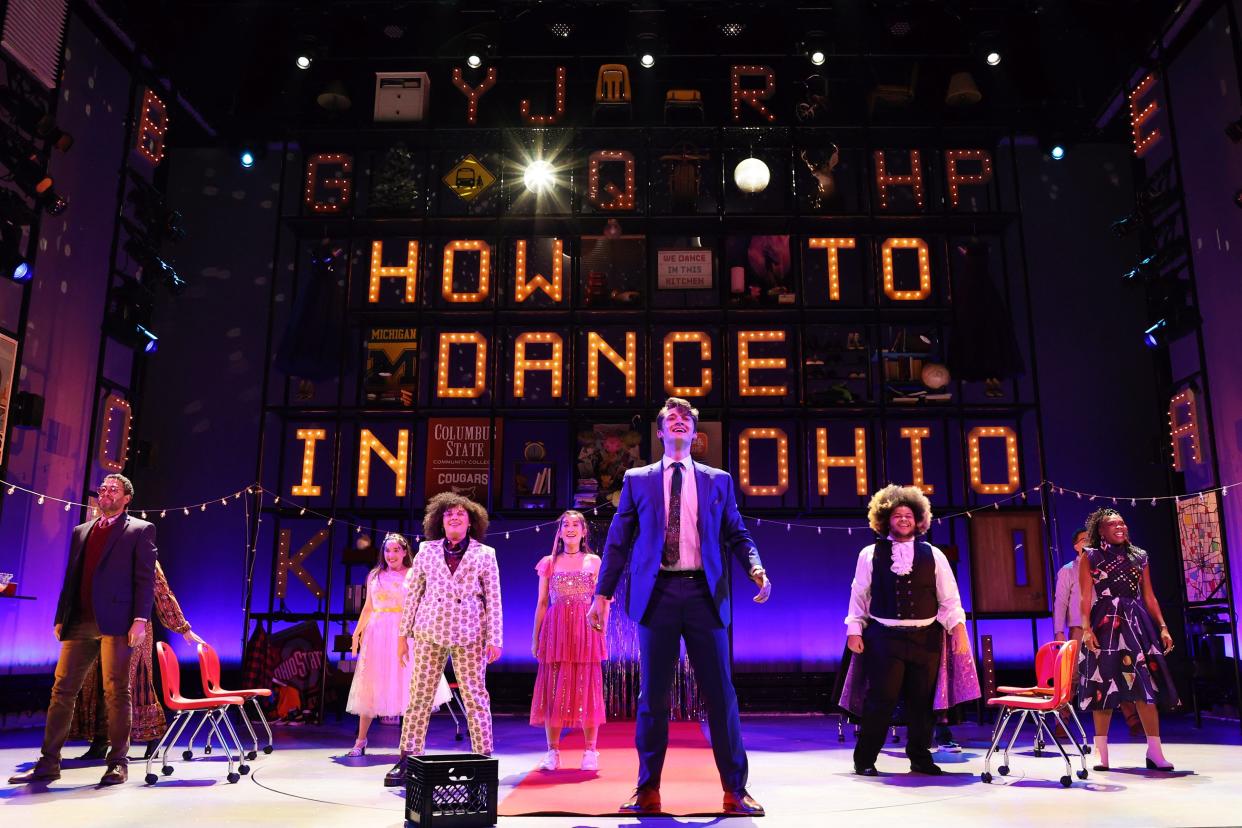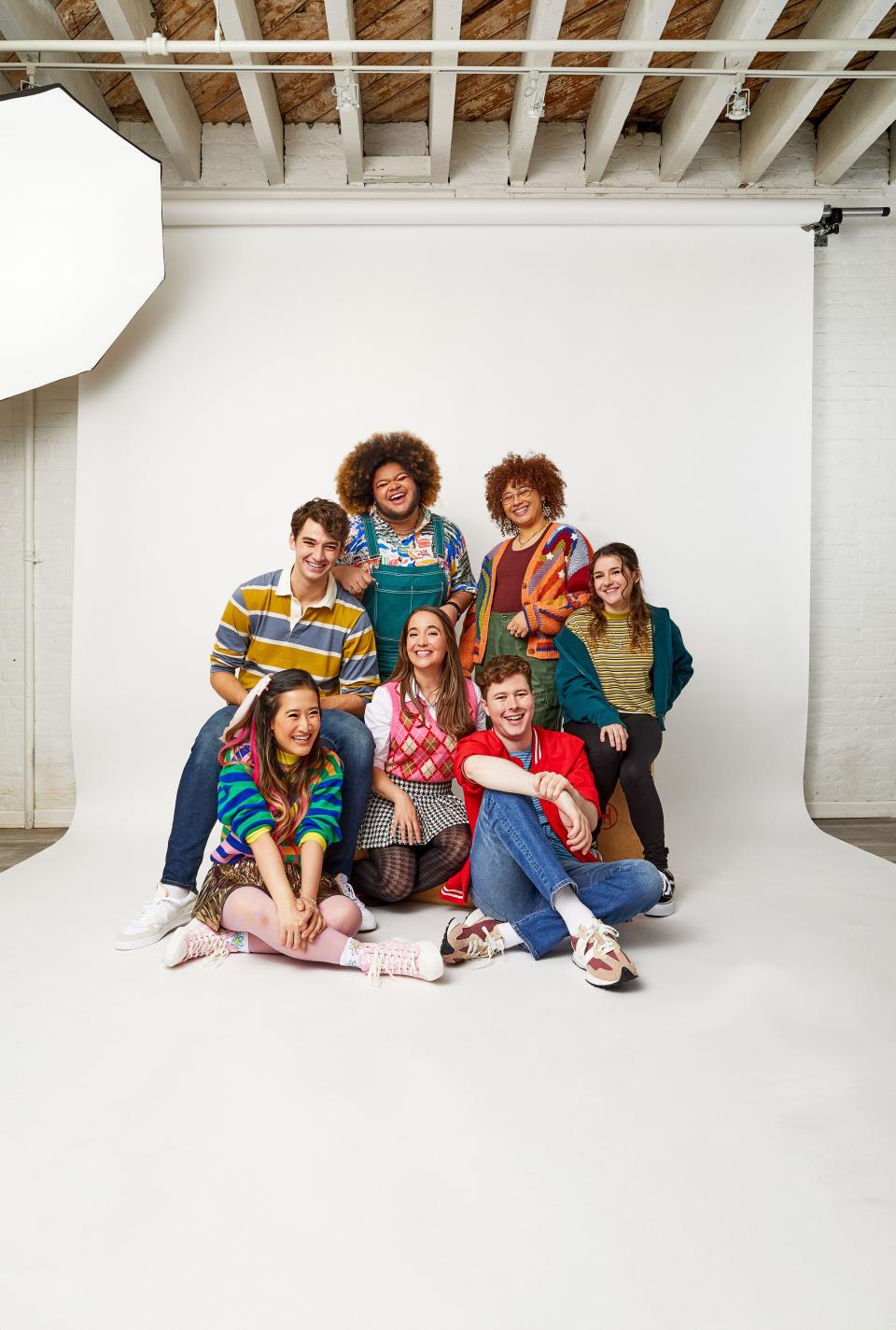New Broadway musical ‘How to Dance in Ohio’ brings a Columbus story to life

- Oops!Something went wrong.Please try again later.
At first glance, the lobby of Amigo Family Counseling on the Far North Side is unassuming, with its neutral, low pile carpet, faux leather chairs and stacks of Columbus Monthly magazines.
But a closer look at the lobby’s walls reveals the special touch of head clinical psychologist Emilio Amigo himself — movie posters, neon-colored signage and laminated graphics of the "autism acceptance" logo: a rainbow-colored infinity symbol representing a spectrum of neurodiversity.
And two specific signs might draw the eye: first, the movie poster for Alexandra Shiva’s widely acclaimed 2015 documentary, “How to Dance in Ohio,” which follows Amigo’s counseling center and the journey his neurodiverse patients take in preparing for their 2013 spring formal.
And secondly, a “How to Dance in Ohio” musical poster positioned next to a hot pink piece of construction paper that reads: "We’re headed to BROADWAY! Opening night December 10th, 2023. Belasco Theatre."
The production, which first premiered last fall at Syracuse Stage in Syracuse, New York, takes inspiration from Shiva’s documentary. Composed by Ohioan Jacob Yandura, the show features an ensemble of seven autistic characters portrayed by autistic actors.
But how did a clinical center in central Ohio become the subject of both a documentary and a musical?
According to Amigo and the people who’ve dedicated years to telling his patients’ stories on screen and onstage, the answer lies in the nature of the doctor's work.
The 2013 spring formal that later became the subject of Shiva’s documentary is part of the center’s greater social skills therapy program, which consists of weekly "Friday Night Clubs," where Amigo opens up every room in the center’s office space and lets his patients practice socializing with one another.
Shiva knew immediately upon visiting the center that Amigo was doing something special, and it was something worth showing to the world.
"It is an incredible place," Shiva said about the counseling center. "(Amigo's therapy style) is unusual and incredibly innovative.”
Shiva had long been inspired to make a film that illustrated what the transition from young adulthood to adulthood is like for people on the spectrum.
“The framework of the dance I thought was a wonderful way to tell this coming of age story," she said.
How the documentary came to be
In January 2013, Shiva and her crew paid a visit to the center to have a town hall with Amigo and his patients. Shiva felt it pertinent to establish right away that Amigo's patients were not merely documentary subjects, but that they would be collaborators on her project.
“It was really important to me that the people on the spectrum were telling us for themselves their experience," she said.
During the meeting, the psychologist and his patients presented Shiva with three conditions: first, the documentary would have to ultimately benefit the patients in their therapeutic journeys, presenting some with new opportunities to expand their social skills, collaborate with strangers, etc.
Secondly, the patients would all contribute to filming in whatever capacity they were comfortable with — some opting to blur their faces, others opting to be filmed but not interviewed. Finally, Amigo insisted that he and his patients be the first to see the documentary before the official release.
So, when the time finally came in 2014, the center rented out a theater at Marcus Crosswoods Cinema for a private screening for all staff and, of course, the stars of the big screen: the patients.
The response was electric and overwhelmingly positive, Amigo said.
“I cried like a baby the whole time,” he said. “It was just who we are, it was so real, it was so raw, it was so honest, and they were true to their word. They were going to respectfully and honestly portray who we are as a community, as individuals, myself as a clinician, as a person, my vision for this practice.”
Soon after, the documentary got picked up by HBO Max (now called ‘Max’), where it has reached millions of viewers, he said. Little did Amigo know, some very influential people were watching.
Ohioans tackle the making of a musical
The seeds for what would later blossom into the upcoming “How to Dance in Ohio” Broadway musical were planted when Jacob Yandura, a 2005 Dublin Coffman High School graduate, was scrolling through then-HBO Max to watch a movie. The documentary title caught his eye — as did the setting, said Yandura, a Kenyon College alum with a master's degree in musical theater writing from New York University.
“I’m from Columbus!” Yandura thought at the time.
Now based in New York, Yandura immediately connected with the film because his sister had been diagnosed with autism around the same time.
After receiving Shiva’s blessing to use her material for a musical, Yandura began composing in 2018, using the 240 hours of documentary footage to craft the story. Right before the pandemic, he and his team brought on director Sammi Cannold, who felt a personal tie to the show, as she has an autistic brother.
The majority of the principal characters in the musical are played by autistic actors — something Cannold and her team knew was essential to telling an authentic story. The production also hired on Columbus’s own Ava Xiao-Lin Rigelhaupt to serve as the show’s autism spectrum disorder (ASD) creative consultant who, using her autistic identity, evaluated the script to ensure authenticity.

Amigo visited Syracuse to see the pre-Broadway performances of the show in fall 2022. He talked extensively with the actors about their experiences incorporating their neurodiversity into their stage performance.
He noticed some of them ‘stimming,’ or exhibiting autistic mannerisms onstage, and later learned that the actors had not been directed to do so. Rather, all those behaviors were completely organic.
"They were encouraged to bring their autistic self to the role," Amigo said. “This is activism. We’re fighting against ableism, we’re fighting against the notion that autism is just something you can portray. It’s not something to portray. It’s an identity first."
Several of Amigo's patients were actually able to travel to New York to see the finished product, including the documentary’s main subjects: Jessica Sullivan and Caroline McKenzie.
“It felt like we were meeting celebrities," Yandura said about meeting Sullivan and McKenzie.
Finally, Yandura, Cannold and their team got the news in June that the show would find a home on Broadway. And Cannold visited Amigo Family Counseling to deliver the news.
“It was very exciting to tell these people — real life people — that their story would go to Broadway,” she said.
'Everybody can be who they want to be'
A decade after he was approached by the documentary film crew, Amigo said “How to Dance in Ohio” is like his “baby.”
He believes his work and his patients’ story speaks to a sense of ostracization he wants everyone to know they can overcome. The lesson strikes a personal chord for the psychologist, who grew up in a predominantly white suburb of Cleveland after emigrating from Cuba at 2 years old.
“I had to always work to fit in,” Amigo said about learning English.
Ultimately, he said, his experience, “compelled me to appreciate and respect all people. ... Everybody has a seat at my table. Everybody can love who they want to love, everybody can be who they want to be."
Shiva shared a similar sentiment.
“The goal (of the documentary) was never to make a piece to highlight how different everyone was. It was actually to highlight the commonality…understanding that human experience is vast and we are all part of it," she said.
For Yandura, bringing Amigo Family Counseling to a Broadway stage gives him a chance to uplift the Columbus community and tell his “home story.”
“So many people that have believed for me and cheered me on for so many years are from this community. To represent our community onstage is truly the best gift of all,” he said.
If the show does well on Broadway, Yandura plans to bring “How to Dance in Ohio” on tour.
And he hopes the tour’s opening night would be hosted at the Ohio Theatre, in the heart of the city that inspired it all.
gtucker@dispatch.com@tucker0527
This article originally appeared on The Columbus Dispatch: New Broadway musical brings this Columbus story to life

